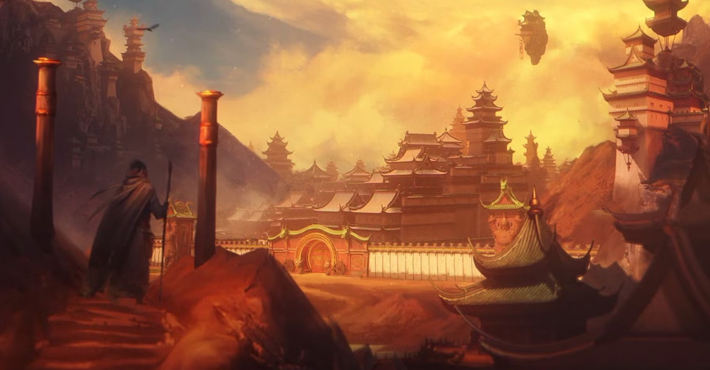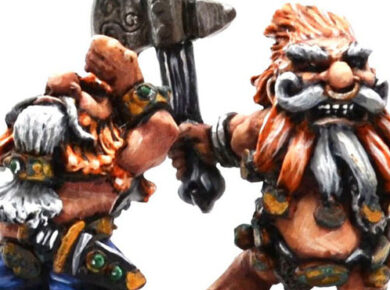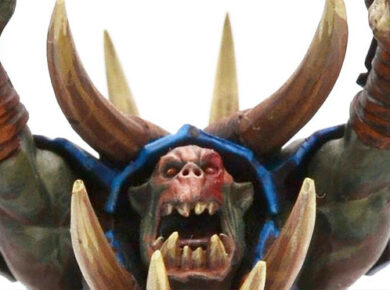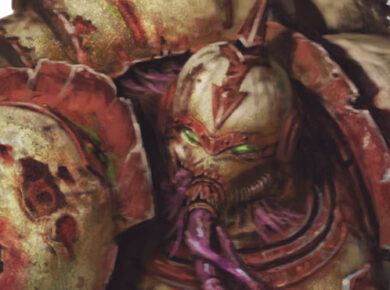Hello everyone,
Today, we’re bringing you a full overview of the Arcane Journal dedicated to Grand Cathay, the highly anticipated new faction in Warhammer: The Old World. Admittedly, we’re coming a bit after the official release of this supplement, but we wanted to share this review with you before diving into coverage of the upcoming Arcane Journals.
The first part of the book is devoted to the history of Grand Cathay. It’s concise but well-structured, we learn about the origins of the Celestial Dragons, their role in maintaining balance within the kingdom, and the narrative spans from the time before the arrival of the Old Ones to the latest events in the Old World. The book also covers the incursion of Chaos and the ensuing cataclysm, diplomatic and military relations with other races, as well as Grand Cathay’s stance in the face of the world’s recent upheavals.
Grand Cathay is presented as a united, hierarchical faction, deeply rooted in learning, discipline, and respect for order, far removed from the internal strife and power struggles typical of other Old World civilizations, which are often ruled by strength or driven by greed. While this historical section is relatively short, it manages to convey just enough to captivate the reader and establish a solid foundation. Lore enthusiasts will find plenty to enjoy, without being overwhelmed by excessive detail.
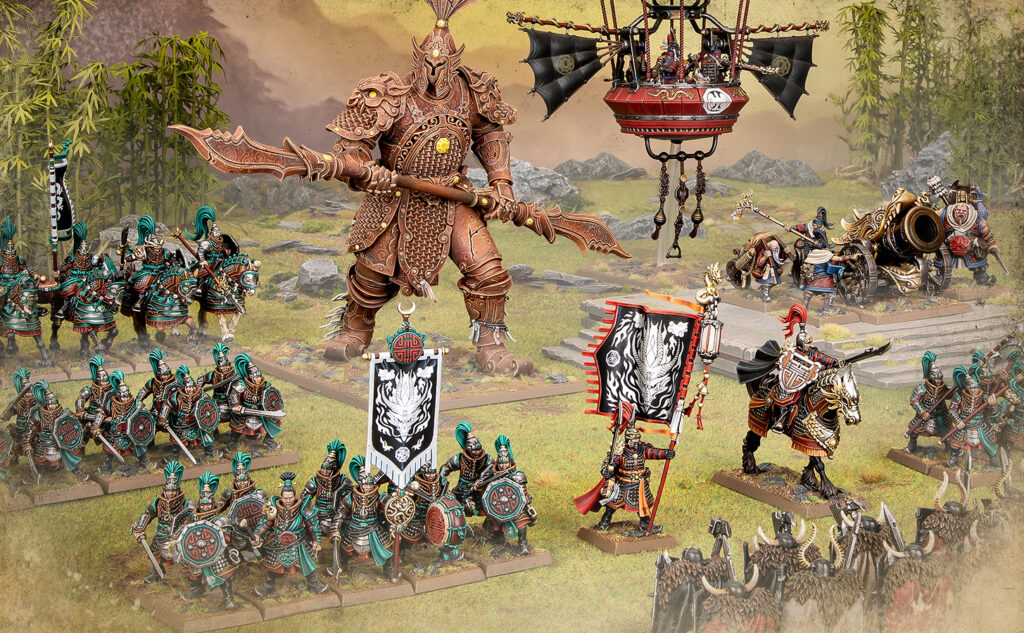
After years of existing solely in the lore, Grand Cathay is finally making its true debut on the battlefield, with an entirely new range of miniatures and dedicated rules. This is a landmark moment, as it’s the first original faction to join Warhammer: The Old World since its launch.
And it’s safe to say the miniatures live up to the hype. They are richly detailed, customizable, and showcase a strong aesthetic that blends heavy armor, classic East Asian influences, and stylized imperial elements. Each unit offers multiple assembly options, and even the basic kits like Jade Warriors, provide great flexibility for building and personalizing your army.
There is, however, one small disappointment. The absence of crossbow options in this first wave, despite their inclusion in Total War: Warhammer III. An upgrade kit for Jade Warriors could have easily introduced more variety without bloating the range. Another point worth noting is that some players might feel the unit variety is still somewhat limited compared to what the video game made popular. In particular, ranged unit options are currently quite scarce, which slightly narrows tactical choices.
That said, seeing an entirely new faction launch with a full plastic miniature range in The Old World is genuinely exciting. It sends a strong message from Games Workshop and is a very promising sign for the game’s future. Grand Cathay isn’t just a lore expansion, it’s a fully realized faction, with a strong visual, military, and narrative identity.
Unlike other Arcane Journals that feature multiple Regiments of Renown or a gallery of special characters, the Grand Cathay volume takes a different approach. Here, the focus is on building a cohesive, self-contained faction, with a complete standalone army list, a single iconic named character, Miao Ying, the Storm Dragon, and content rich in lore, rules, and magic.
The army list includes everything you’d expect from a well-developed faction: infantry, cavalry, artillery, monsters, and more. On top of that, there are three new character types, two war machines, and most notably, a dual magic system built around the schools of Yin and Yang. This original approach adds depth without unnecessary complexity, making the faction feel truly alive, even for players who aren’t familiar with Total War: Warhammer.
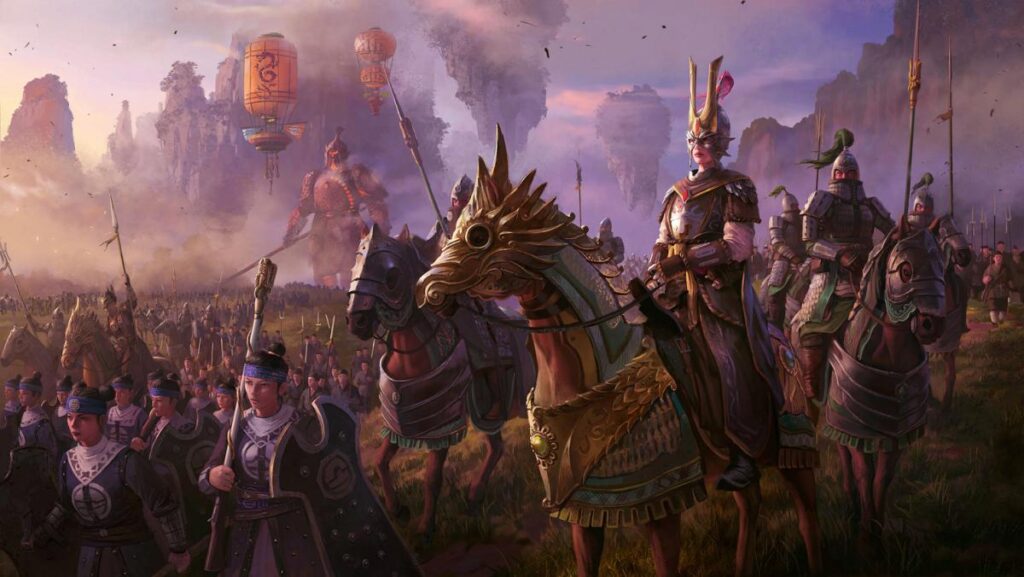
Gameplay Rooted in Balance, Discipline, and Magic
Grand Cathay stands out from other Old World armies with gameplay that revolves around unit synergy, rank discipline, and clever use of magic. Several special rules, particularly those tied to the Yin/Yang balance, reinforce this unique identity. The result is a gameplay experience that is both subtle and rewarding, relying more on mastery and coordination than on raw force. It’s a deliberate contrast to more straightforward factions like Bretonnia or the Greenskins, making Grand Cathay an excellent choice for players who enjoy a more deliberate, strategic playstyle that is nonetheless just as deadly.
Now, let’s turn to the actual army list. Grand Cathay is presented here as an expeditionary force, an elite troop sent into the Old World, explaining its relatively focused but coherent composition. This leaves room for the possible inclusion of more complete regional lists in the future.
The army structure follows the classic rules format:
- Characters: maximum 50% of the total points
- Core Units: minimum 25%
- Special Units: maximum 50%
- Rare Units: maximum 25%
Characters:
Cathayan Dragons are unique characters, limited to 1 per 1000 points. They can be fielded in either their human or draconic form. Currently, only Miao Ying, the Storm Dragon is available. However, it seems likely that more Dragons will be added in the future, especially if we go by the expectations of Total War: Warhammer III fans, who already have a few guesses about who might be next…
You may include 0–1 Shugengan Lord or Magistrate Lord per 1000 points.
- The Shugengan Lord is a powerful warrior-mage, a kind of half-dragon.
- The Lord Magistrate is a support character, historically representing the governors of Cathayan provinces.
Unrestricted Characters:
- Shugengan: less experienced half-dragons
- Gate Keepers and Gate Masters: sturdy frontline warriors
- Strategists: less powerful characters from the Magistrate caste
Note: The Gate Keepers fulfill the role of Battle Standard Bearer in the army list.
Core Units:
Unfortunately, this is where the unit selection is most limited. As a celestial expeditionary force, the army includes no peasant units (no archers, light spearmen, or peasant cavalry).
The only available core units are:
- Jade Warriors, who can be equipped with either basic weapons or spears.
- For every 1000 points, you may also include 1 unit of Jade Lancers, representing Cathay’s heavy cavalry.
Special Units:
On the special units side:
- Jade Lancers (yes, them again!) return, allowing you to build your army around cavalry.
- The artillery pieces are present and honestly quite impressive visually. They are limited to 0–3 per 1000 points.
Depending on the chosen general, you also gain access to:
- A Cathayan Sentinel as a special choice, if the general is a Shugengan Lord or Shugengan.
- A Celestial Lantern as a special choice, if the general is a Magistrate or Strategist.
The number of entries remains modest, but the system offers interesting variations that allow you to tailor your lists according to your playstyle.
Rare Units:
The rare units include:
- The impressive Cathayan Sentinels, true monsters on the battlefield.
- The elegant and powerful Celestial Lanterns.
Mercenaries & Allies:
Up to 20% of your army can be composed of mercenaries.
Allowed Allies:
- Other Grand Cathay armies (pending possible regional variants in the future)
- The Empire
- The High Elves
- Bretonnia and the Wood Elves are mentioned as Suspicious allies.
The Dwarfen Mountain Holds are not allied with Grand Cathay, likely due to historical tensions or conflicting commercial interests. However, they can recruit units from Grand Cathay as allies, just like the Empire and Bretonnia.
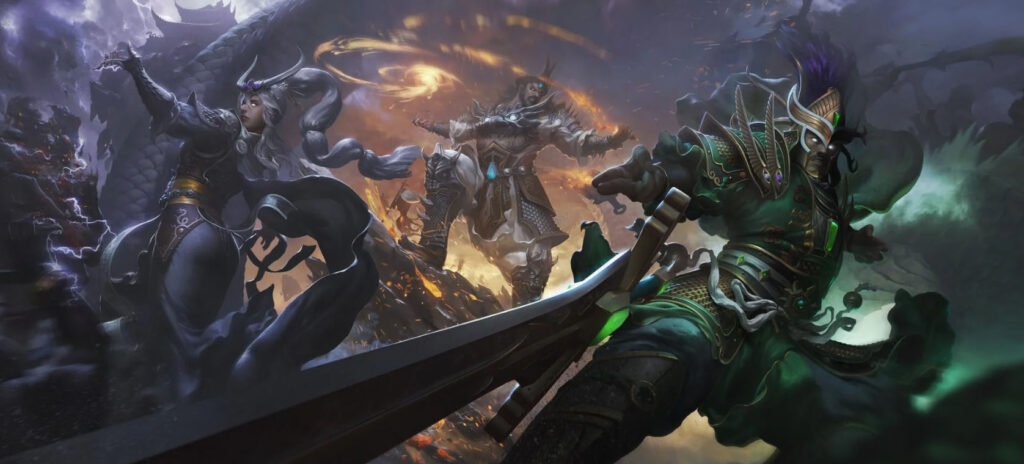
Special Rules of Grand Cathay:
Like other armies in Warhammer: The Old World, Grand Cathay has a few special rules that give it its unique identity on the battlefield. These are simple mechanics to remember but effectively convey the balance, discipline, and mystical power of the Celestial Empire.
Celestial Forged Armour (X+):
If a miniature has Celestial Forged Armour (X+), it gains an invulnerable save corresponding to the number indicated. For example,Celestial Forged Armour (6+) means an invulnerable save of 6+. It can be compared to Chaos Armor, but tailored to reflect Cathay’s nature.
Mastery of the Elemental Winds: This rule applies to Shugengan. Once per turn, a wizard with this rule who is within 6 inches of another Shugengan gains +1 to their spellcasting roll. A small, simple, and effective bonus that encourages building lists with multiple mages to optimize Cathayan magic.
Will of the Dragons: Present on Jade units and certain characters, this rule reflects the discipline and mental resilience of Grand Cathay’s troops. It allows a reroll of a panic test if it is caused by the destruction of an allied unit within 6 inches or by a friendly fleeing unit passing through yours. Again, this is a subtle mechanic that reinforces army cohesion and its playstyle focused on holding the line and elite strength.
The Elemental Winds: Inspired by Total War: Warhammer III, this rule reflects the mystical influence of the Yin and Yang winds on the battlefield.
How it works:
At the start of each turn, the Cathayan player rolls 1D6:
- On 1–3: the Yang wind blows.
- On 4–6: the Yin wind blows.
Depending on the active wind, different bonuses apply until the next start-of-turn sub-phase. All eligible models must choose the same bonus from the two offered.
Yang winds:
- Wizards mastering Yang magic:
- Increase the range of their enchantment spells by 3 inches.
- And their dispel range by 3 inches.
- Models with Will of the Dragons rule:
- Gain either +1 Movement or +1 Initiative.
Yin winds:
- Wizards mastering Yin magic:
- Increase the range of their curses and arcane missiles by 3 inches.
- Models with Will of the Dragons rule:
- Gain either +1 in Combat Ability or +1 in Command.
This wind rule is a great idea because it brings strategic flexibility without leading to overpowering effects. The bonuses are useful but measured, and above all, situational. This system encourages a bimodal composition (with both Yin and Yang wizards) to make the most of each wind depending on the roll. It’s also worth noting that the winds do not grant bonuses to Strength or Attacks, which prevents abuse while maintaining the mystical yet disciplined identity of the faction.
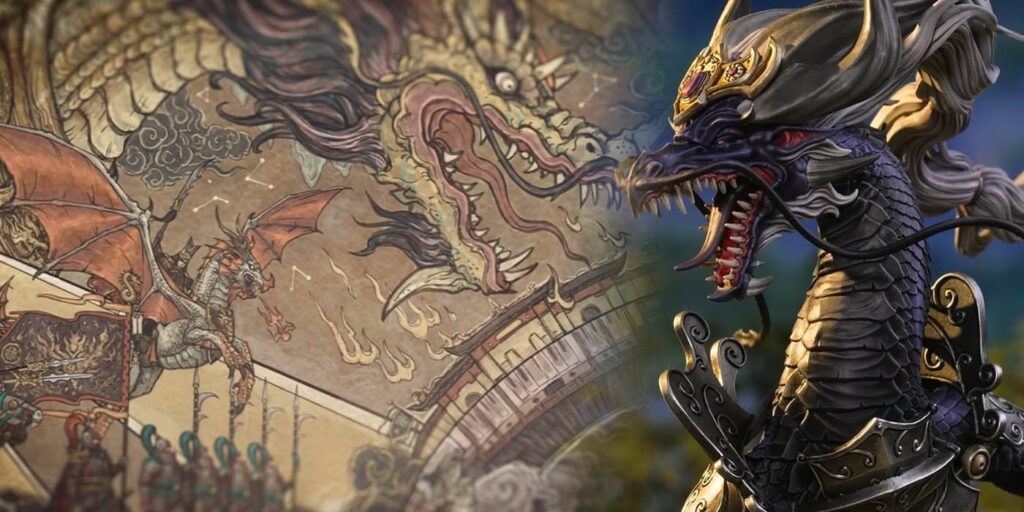
Before we begin, a quick clarification. We won’t be diving into an in-depth competitive analysis of each unit. Our approach is primarily narrative and passionate. If you’re looking for sharp optimizations or tournament combos, specialized sites like Goonhammer already do that very well. We prefer to tell stories on the table and focus on collecting!
Miao Ying, the Storm Dragon:
The model is absolutely stunning, whether in her human form, full of grace and movement, or in her draconic form, worthy of the most majestic Chinese dragons, reimagined with a Games Workshop twist. The only minor drawback is the scenic bases, which lack a bit of coherence. It feels like the stones are just popping out of nowhere. We would have preferred the same idea, but better integrated into the base. A little modeling work might be necessary to truly elevate the model.
She’s a character capable of transforming during the battle. Although her cost of 485 points may seem intimidating, she remains a powerful model well worth it. In my opinion, she’s better suited for large-scale games rather than a standard 2,000-point list. In any case, if you include her in your army, she will automatically become the general. She is subject to the “Monster Hunter” or “Killing Blow” rules, depending on her form (heavy infantry or behemoth character). She is neither immune to morale nor to psychology, which allows her to flee if necessary but makes her vulnerable to panic. As a wizard, she is level 4 in human form and level 2 in draconic form. She can draw from Battle Magic, High Magic, and Elementalism.
Special rules and abilities:
- Disdain of the Dragons: An enemy wishing to challenge Miao Ying must pass a Command test with a penalty: +1 in human form, +2 in draconic form. If they fail, the challenge does not take place.
- Master of the Storm Winds: You can swap two random spells for Yin or Yang spells of your choice, her signature domain spell, or the signature spell The Storm Dragon Fury. The latter is a magical projectile (casting on 10+, range 18″), inflicting 2D3 hits of Strength 5, AP -3, with Flaming Attacks. Additionally, the hit unit must immediately fall back, creating a significant strategic impact. This spell is unique to Miao Ying and is definitely worth including.
- She also allows you to transform one unit of Jade Warriors and one unit of Jade Spearmen into Celestial Dragon Guards for 1 point per model. This grants them +1 to Combat Ability, +1 to Leadership, and Celestial Armor (6+).
- The Wrath of the Storm rule grants all your units of Jade Warriors and Jade Spearmen the Chaos Hatred special rule.
Equipment:
Whether wielding the Talon of the Storm in human form or unleashing the Dragon’s Breath in draconic form, her weapons are simply devastating, but that’s the bare minimum one would expect from a being of such immense power.
Transformation Mechanic:
At the start of the game, you must choose the form in which Miao Ying is deployed.
Important: In her draconic form, she does not benefit from Inspiring Presence (she therefore does not provide her Command bubble). She may change form during the Command sub-phase of your turn. This allows, for example, repositioning before a charge, or transforming to better adapt to the tactical situation.
Each time she transforms, she regains D3 Wounds. Although her Wounds are shared between both profiles, if she loses all her Wounds while in draconic form, she immediately reverts to her human form, regains D3 Wounds, but can no longer become a dragon for the remainder of the game.
This can offer a kind of tactical fallback, survive an offensive, retreat, cast spells from a distance, and wait for reinforcements to turn the tide.
The Shugengans:
Let’s be honest, the Shugengan model is absolutely stunning. Its design elegantly blends mystical elements with imperial majesty, perfectly aligned with Grand Cathay’s aesthetic. Regardless of the build option, this character must be mounted on a Longma, and comes on a 60×100 mm base, placing it firmly in the monster-mounted character category.
Profile-wise, the Shugengan has a solid number of Wounds, good Leadership, and the Always Strikes First rule, making him slightly more threatening in melee than a typical wizard.
But where the Shugengan truly shines is in his magical versatility. He can tap into a wide range of lores: Yin, Yang, Battle Magic, Elementalism, Illusion, and High Magic. This allows him to adapt to various playstyles, support, harassment, control, or offensive buffing. Shugengans are also the only characters who can fully benefit from the Mastery of the Elemental Winds rule, especially when played in synergy with other Shugengans.
He’s a very well-designed character, useful, balanced, and fitting for a half-dragon, neither overpowered nor underwhelming. He fits seamlessly into an army that values magic and discipline. That said, we would have liked a bit more variety. The model only exists mounted on a Longma, and a foot version would have been a welcome option, not just for more list-building flexibility, but also to open up further uses of the Mastery of the Elemental Winds rule. Finally, the second build option included in the kit lacks strong visual differentiation. Both versions look quite similar, which is a bit of a shame for a character of this calibre.
Gate Masters:
These models are understated, well-detailed, and blend seamlessly with the Jade Warriors. They come well-equipped and with solid stats. Their special rule, Harmony of Stone & Steel allows their unit to re-roll all failed tests when redirecting a charge, restraining pursuit, or reforming after a successful pursuit. This makes them excellent strategy stabilizers, especially in an army where movement is key.
Magistrates:
The main drawback is that the on-foot version is only available inside the Celestial Lantern, which means you can’t field a Lantern without tying it to the character. That said, placing a Magistrate in a Celestial Lantern bumps him up to 10 Wounds, which is far from trivial. His special rule, Strategic Mastermind, is powerful, it grants a 9″ bubble in which friendly units may use his Leadership.
In addition, once per turn, one friendly unit within that bubble, after winning a combat, may choose to reform in good order instead of pursuing.
This allows you to reposition immediately, and if it’s your turn next, charge again with all the associated bonuses: impact hits, initiative boosts, etc. A real tactical surprise to spring on your opponent…
Jade Warriors:
A visually stunning unit, and clearly elite for a core choice. For just 8 points, with full equipment and Will of the Dragons rule, they are very well optimized.
Add to that Defensive Stance, which allows the unit to re-roll 1 on armour saves if it hasn’t charged, and you’ve got a near-staple unit in most lists, especially since it’s almost the only core option available. Cathayan frontlines are tough, defensive, and can be smartly enhanced through the use of Elemental Winds.
Jade Lancers:
Jade Lancers offer a tactically interesting alternative. In essence, they are mounted Jade Warriors for 20 points. The unit can benefit from notable options such as Well-Trained, Stubborn, or Ambushers, or even all three, while also boasting a base 3+ save. They also benefit from the unique Cathayan Cataphracts rule, which allows them to pursue fleeing enemies and count as having charged in the following turn.
This is a fairly unique mechanic in the game, and since they also benefit from lance bonuses and increased initiative on the charge, their impact shouldn’t be underestimated. This effect can be devastating, but balance is maintained thanks to their Toughness 3 and 3+ armour save, which, while solid, doesn’t make them invincible.
The Celestial Lantern:
The Celestial Lantern is a centrepiece model in the Cathay range, impressive in size, design, and the sheer finesse of its details. It’s yet another showcase of Games Workshop’s craftsmanship, masters of the miniature-making art. This engine can serve as a mount for a Magistrate or Strategist, and at 135 points, its cost-effectiveness is excellent. It’s already shaping up to be a potential meta-defining unit, thanks to how easily it can become a tactical nightmare for your opponent.
The Lantern is complex to manage, as it relies heavily on rules tied to mobility and positioning. Its true strength lies in its tactical flexibility, notably through several special rules:
- Eye of the Dragon: This ability allows rocket batteries (units with the Bombardment rule) to benefit from the Lantern’s line of sight. Given the sheer size of the model, it can see almost everything, especially since it also has the Scout rule, allowing for optimal deployment positioning at the start of the game.
- Disengage:
If the Lantern loses a combat, it may take a Leadership test. On a success, it falls back in good order, without giving up ground, and the enemy may only follow or restrain pursuit. Conversely, if the Lantern wins a combat, it may also choose to disengage in good order, this time without a test.
This makes it difficult to lock in melee and gives it the chance to reposition and charge again with all associated impact bonuses. - Celestial Beacon: Friendly units within 12 inches may re-roll failed Panic and Rally tests, as if they were in range of a Battle Standard Bearer.
Additionally, this rule allows you to apply a +1 or -1 modifier to the Ambushers’ arrival roll, giving you extra control over when and where they enter the battlefield.
In addition, the embarked Strategist provides a native Command aura, even if he is not the army’s general, which further enhances the unit’s strategic value on the battlefield.
The Celestial Lantern is also well-armed:
- Iron Hail Guns: A burst of reliable firepower that can quickly make a difference against lightly armored units.
- Sky Lantern Crane Guns: Less reliable, but very powerful when it hits.
- Bombs: More anecdotal, but fun and potentially disruptive, they can throw off your opponent’s plans in unexpected ways.
he only real point of contention lies in the Lantern’s exceptional mobility, made possible by a number of rules that allow it to constantly reposition. This could potentially unbalance certain games, and it’s not out of the question that this ability may be revised in the future to limit possible abuse.
The Sentinels:
Another impressive beast in the Cathay range! For 230 points, this terracotta behemoth commands the battlefield with both its size and presence. Right off the bat, it benefits from a 6+ Regeneration thanks to its terracotta nature. However, this ability can be upgraded by selecting a specific type of stone, each granting unique bonuses and replacing the base regeneration.
- Jade Sentinel (+20 pts): Gains a random spell from Battle Magic or Elementalism. The concept is interesting, but the lack of spell choice limits its effectiveness, making it a currently suboptimal option.
- Obsidian Sentinel (+25 pts): Grants Magic Resistance (-2) and forces enemy wizards within 12 inches to take a Leadership test before casting. On a success: -1 to the casting roll. On a failure: -3 to the casting roll. A very strong option against magic-heavy armies, enhancing your control of the mystical battlefield.
- Granite Sentinel (+35 pts): Gains a 4+ armor save and becomes immune to Multiple Wounds. A perfect pick if you’re looking to make your Sentinel tougher and more durable over the course of the game.
- Warpstone Sentinel (+40 pts): Deals magical attacks and inflicts -1 Toughness on enemies in close combat. This significantly boosts the Sentinel’s lethality, especially against elite or resilient units.
The Sentinel has the Relentless rule, once per game, if the Sentinel is charged and loses the combat, it may choose to refuse to give ground. Once per game, it may also re-roll a failed charge roll. These rules add reliability without being overpowered.
The Sentinel has two attack profiles. Sweeping Blow: Ideal against infantry. Up to 9 attacks, WS5, S6, AP-2, Rend (1), efficiently clears enemy ranks. Crushing Strike: Specialised for anti-elite or monster targets. +1 Strength, AP-4, Killing Blow, Monster Slayer, Multiple Wounds (D3), effective against precise and resilient targets.
In Warhammer’s vast universe, it’s not the most destructive monster, and it remains vulnerable to war machines. That said, it is still a solid offensive monster, reasonably tanky, while offering strong strategic versatility. From a lore perspective, it’s easy to imagine these Sentinels defending the walls of Cathay against invading forces. Their inclusion in an expeditionary list might seem questionable… unless you take inspiration from Total War: Warhammer III, where these constructs accompany Cathayan armies across seas and continents. This nod to the video game helps justify their presence on the battlefield.
Cathay Artillery:
Cathay offers two main artillery pieces, both available from a single multi-option plastic kit, the Fire Rain Rocket Battery and the Great Cannon. These war machines, priced at 130 points, are not only powerful but also essential, as they currently represent Cathay’s only source of long-range firepower.
The Fire Rain Rocket Battery is a multi-profile artillery piece with two types of ammunition, each with very different effects.
It has the Bombardment rule, which synergizes perfectly with the Celestial Lantern, thanks to its Eye of the Dragon ability that allows it to use the Lantern’s line of sight.
Bastion Rocket:
- Range: 12–48″
- Strength: 4 (6 through the central hole)
- AP: -1 (-3 through the hole)
- Rend (1), Multiple Wounds (6) through the hole
- Template: 3″
- Catapult, Bombardment, Bulky, Move or Shoot
- Black Powder Incident
Fragmentation Shots:
- Range: 12–48″
- Strength: 3 (4 through the hole)
- AP: -1 (unchanged)
- Rend (1), Template 5″
- Catapult, Bombardment, Bulky, Move or Shoot
- Black Powder Incident
- Wailing Spirits: any loss of wounds forces the targeted unit to take a panic test.
A fearsome anti-horde weapon, capable of sowing chaos in enemy ranks even with moderate damage.
The Cathayan Great Cannon is an extremely dangerous anti-monster and anti-chariot piece, with a secondary effect that slows the enemy.
- Range: 48″
- Strength: 10
- AP: -3
- Rend (3), Multiple Wounds (D3+1)
- Cannon Shot, Bulky, Move or Shoot
- Thunderous Impact: any unit (friendly or enemy) within 2D6″ of the impact point suffers -1 Movement and loses the Fast rule
The Ogre Artillery Crew, for an additional 35 points, can accompany a war machine, granting it the following upgrades:
- +1 Movement to the war machine
- Stubborn
- Access to black powder bombs for an additional 8 points (close defense)
- Once per game, the war machine can shoot twice during the shooting phase or reroll one artillery die
It’s a significant asset in terms of power and reliability, especially for critical shots against monsters or large units.
Cathayan artillery is powerful for its cost (130 points), and its versatility, anti-infantry (fragmentation), anti-elite (bastion), and anti-monster (cannon), makes it a cornerstone in any army. Being able to field up to three per 1000 points allows a Cathay army to compensate for its lack of ranged firepower by relying on this potent artillery.
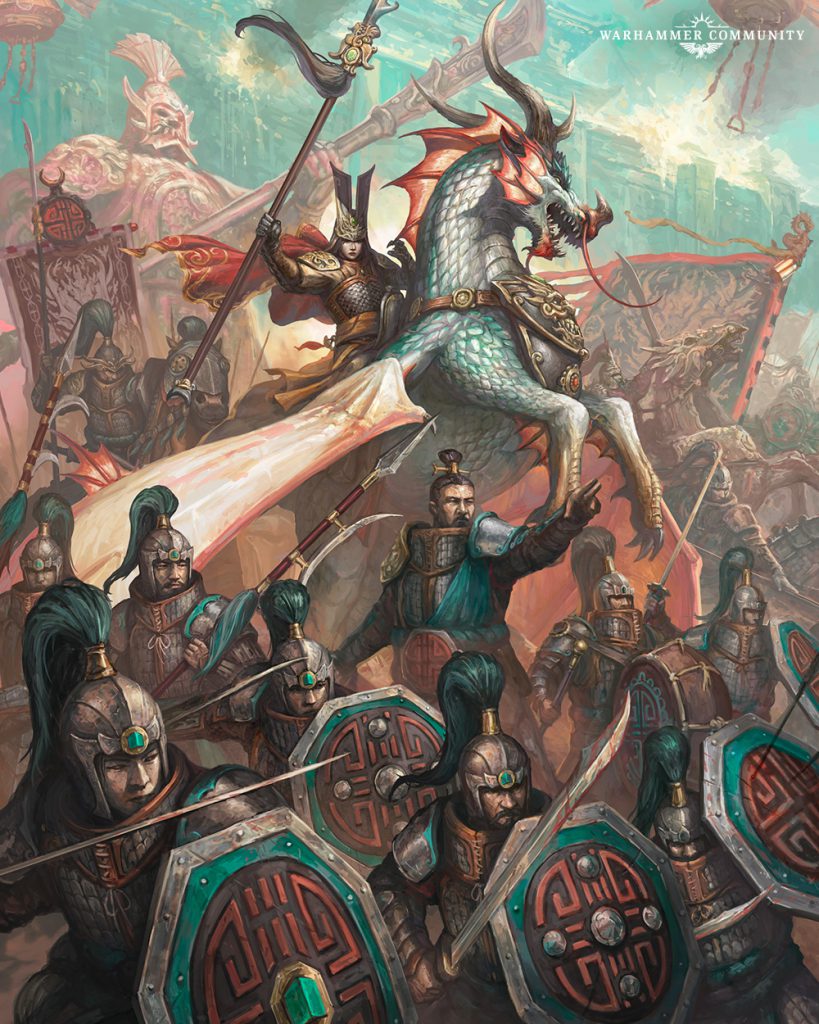
Magic Items:
As expected, Cathay’s Arcane Journal does not disappoint when it comes to magic. The army offers a range of magical items that are as powerful as they are thematic.
The Monkey King’s Wisdom (75 pts):
This weapon draws inspiration from the myth of Sun Wukong. It turns the bearer into a pure monster-slayer — ideal for taking down powerful units and giving monsters a hard time.
Melee weapon (two-handed), S10, AP -4, magical attacks, D3 wounds per hit, Strikes Last.
Jade Blade of the Great Fleet (70 pts):
+2 Strength, AP -2, Rend (1), magical attacks, Regeneration 5+. An excellent weapon for keeping the bearer durable while maintaining steady damage output. With this blade, Shugengans can benefit from three different saves, making it a very strong gear choice.
Spirit Longma Spear (25 pts):
+1 Strength, AP -3, Rend (1), magical attacks. Nothing exceptional at first glance, but the unexpectedly high AP can make a difference, for example, in duels.
Sun and Moon Blades (20 pts):
Base Strength, AP -1, +1 Attack, magical attack, two-handed weapon. If the bearer suffers a Killing Blow, roll a D6: on a 4+, the blow is deflected and has no effect. For its low points cost, it’s a great pick for a Magistrate or a Gate keeper, adding a bit more survivability.
Magic Armours:
The Armour of the Warbird (45 pts):
For light or heavy infantry. The bearer gains Counter-charge, Fly (9″), and Fast, but cannot join units. Useful for creating a mobile, support-oriented offensive character, depending on your strategy. Not an essential pick, but can be very relevant depending on your list composition.
Shield of Nan-Gau (20 pts):
Grants +2 to armour saves when the bearer is charged. Perfect for heroes likely to be targeted by charges, as it can potentially bring their save down to 2+ depending on equipment. Interesting for its points value.
Talismans :
Crystal of Kunlan (35pts): 5+ Ward Save. “For each successful ward save of 6, an enemy model in base contact suffers a Strength 3 flaming hit.” It’s a fun little piece of gear to use, depending on your army composition.
Jade Crown (20pts): 4+ Ward Save against magical missile spells, magical vortexes, or assailment spells. Interesting for its points cost.
Magic Standards:
Standard of Wei‑Jin (40pts): Causes Fear. Enemies within 12″ suffer a -1 Leadership penalty when taking Fear, Terror, or Panic tests. While effective in certain situations, this ability becomes useless against Undead, making it a risky choice in lists designed for random or unknown opponents.
Icone of FuryIcon of Heavenly Fury (35pts): One use only. Activate during the Command sub-phase of your turn. Until the start of your next turn, no enemy unit may use the Fly special rule. A powerful banner that, under the right circumstances, can have a major impact, potentially even turning the tide of a game.
Dragon’s Eye Banner (30pts): If an enemy wizard attempts to target the bearer with a spell, roll a D6: on a 3+, they must choose another valid target instead. With a bit of luck, this can even negate a spell entirely if no other eligible targets are available.
Banner of the Bastion (25pts): The unit gains the Shield Wall special rule. An excellent choice to enhance the durability of a unit of Jade Warriors, significantly improving their resilience on the battlefield.
Enchanted Items:
Maw Shard (40pts): If an enemy wizard rolls a double when casting a spell while within 18″ of the bearer, a Miscast is automatically triggered. Its range and reliability make it a particularly dangerous item. For example, it can be carried by a Magistrate on Lantern, turning them into a true nightmare for enemy spellcasters.
Alchemist’s Mask (35pts): Can cast the spell Metal Plague from the Elementalist lore as a bound spell, with a power level of 3. In my opinion, the Maw Shard should be a priority when spending points.
Lantern of Spirits (25pts): Causes Terror. The bearer may reroll wound rolls of 1 against Undead and Daemons. Situational.
Arcane Items:
Po Mei’s Cloak (50pts): In addition to their randomly generated spells, the bearer knows all the spells from either the Yin or Yang lore (your choice). However, they can only cast a number of spells equal to their Magic level. This ability grants excellent versatility with 6 spells at their disposal, offering a wide range of options depending on the situation.
Guardian Feng Shi Bo (35pts): Grants a -1 penalty to hit rolls against the bearer in close combat. Useful, especially since it can be equipped by multiple characters and Shugengans are quite capable in melee.
Learned Feng Shi Bo (15pts): The bearer knows one additional spell. Once again, this benefit can be taken by multiple characters and, given its points cost, can be an effective complement to your list.
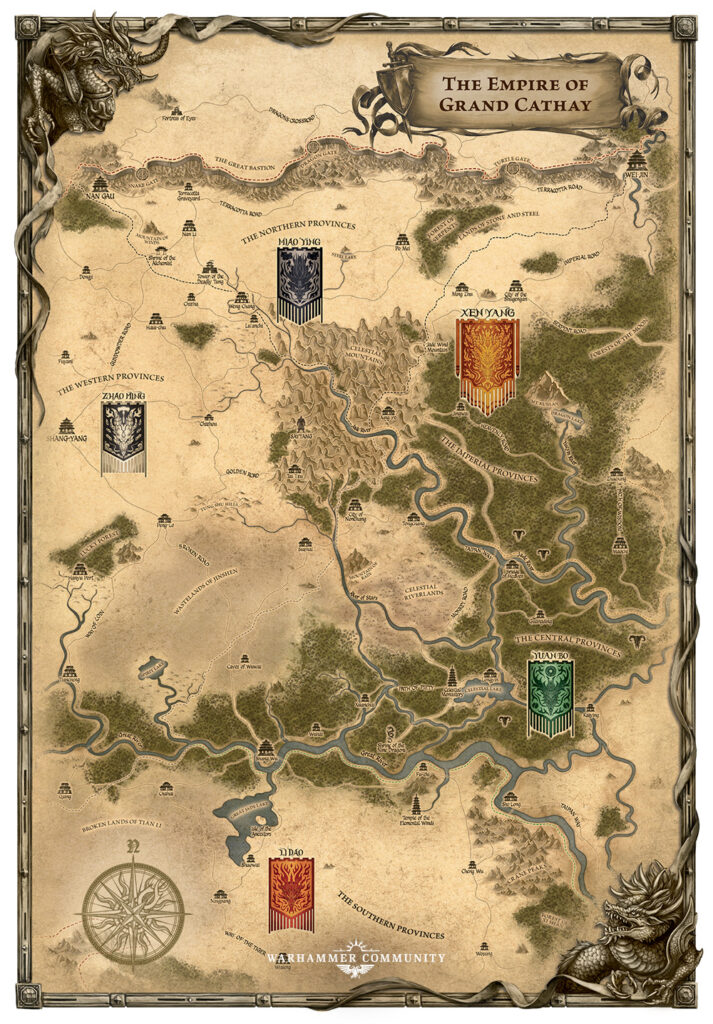
We now come to the final section, dedicated to the spells of Yin and Yang. Your choice will play a crucial role in your strategy and army composition, while adding genuine depth to the lore of Cathay.
Yang :
Constellation of the Dragon : A magic missile with an 18″ range and dual casting values. At 7+ to cast, the spell inflicts D6+1 Strength 4 hits with no armour penetration, making it a decent, though not exceptional, magic missile. However, at 11+, you get 2D6+2 Strength 4 hits with -1 armour penetration, which clearly puts it in the top tier of spells.
Great Bastion : An enchantment cast on a 9+ with a 12″ range. This Remains in Play spell grants the target unit a 6+ Ward Save. In addition, any model in the front rank of an enemy unit that completes a charge into base contact with this unit must take a Dangerous Terrain test. Wounds caused this way count towards combat resolution. It’s a mediocre spell overall, but in a defensive army, it can help chip away at elite units or cavalry, potentially causing the opponent to lose a few valuable models before the fight even begins.
Might of Heaven & Earth : On a 9+, the caster, their mount, and the unit they have joined gain +1 Weapon Skill, +1 Strength, and the Flaming Attacks special rule. However, if the spell is cast on a 12+, all friendly units within your Command Range receive these bonuses! This spell can be truly powerful, and given the high casting values, it will most likely be Miao Ying who casts it.
Yin :
Spirits of Wind & Shadows : This is a hex spell with a 15″ range and a casting value of 10, which can make it a bit tricky to cast. Until your next Start of Turn sub-phase, the targeted enemy unit gains the Random Movement (D6) special rule. This spell has incredible strategic potential, it can prevent an enemy unit from getting close enough to shoot, slow down a fast-advancing monster, or allow your wizards to stay safely out of charge range. And don’t forget: with the Winds of Yin, the range increases to 18″!
Accursed Mirror : This is a hex spell with a casting value of 9+ and a 15″ range. Until your next Start of Turn sub-phase, every natural roll of 1 to hit made by the targeted enemy unit, whether in shooting or close combat, causes a Strength 3 hit with -1 Armour Penetration against themselves. An excellent spell for dealing damage to large enemy shooting units, directly punishing them for every missed shot.
Ancestral Warriors : An Assailment spell with dual casting values. On a 7+, it deals 2D3 Strength 2 hits with no armour penetration, which, as you can imagine, isn’t particularly impressive. But on an 11+, those strikes upgrade to 2D6 Strength 4 hits, with -1 Armour Penetration and the Armour Bane (2) rule. Now that becomes serious, and can definitely deal real damage to your opponent.
So, we’ve now gone through all the spells, and as you’ve probably noticed, the Lore of Yin clearly stands out as the most powerful. On top of that, the Winds of Yin grant +3″ range to your spells, making them even more effective on the battlefield.
That wraps up our review of Cathay’s Arcane Journal. We know we’re not the first to cover this, and there are surely more in-depth or expert analyses out there, but this was something we really wanted to do, and it took a lot of time and passion to put together. As you might have guessed, we’ve fallen in love with Grand Cathay, and there’s a good chance we’ll be diving into a dedicated army/modelling project sometime in the near future.
Don’t missed to support us on PATREON!
Questions, ideas, spelling error or just want to share your thoughts? Leave a comment below! And if you enjoy our work, a little support would help us keep creating more and more content.
See you soon!
